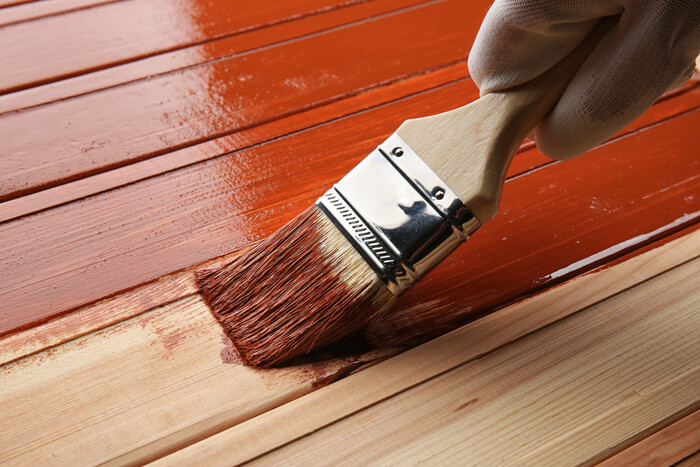When it comes to decorating a log cabin, people pay most attention to making the interiors warm, welcoming, cosy and comfortable; but paying attention to the exteriors of the log cabin is equally important. The colour of your exterior walls says as much about your home as your interiors. In addition, without the proper care and maintenance of exteriors, your beautiful log cabin could become a victim of the weather and erode, eventually breaking down. Always remember that the exterior of your log cabin is more exposed to various harmful and damaging elements like UV rays, wind, dust, rain, snow etc.

The exterior of your log cabin is the first aspect of your cabin that anyone will see. As a result, it is vital that those walls get as much attention as your interiors. Painting is the quickest way to transform the appearance of your walls. You can easily brighten up the look of your cabin and give it a fresh new look that appeals everyone.
As already mentioned, the exterior of a log cabin is open to harsh elements, so with the passing of time the colour of the paint fades. Painting exterior walls also gives your residential log cabin a protective layer against the elements. And it’s best to remember that skimping on quality may result in damage to the structure of your cabin. For example, if moisture is sealed into walls, it can result in rot and mould ‒ it is better to incur the minimal cost of painting the exterior walls than bearing the heavy costs of dealing with moisture damage. The sun also plays a key role in slowly spoiling the paint. The colour can fade and the UV rays can break down the binder of the paint. Similarly, exposure to rain can cause the paint to peel off in strips. Therefore, it is important to choose the right type of paint that is best suited for extreme atmospheric conditions. Paints can last from 7-10 years when properly applied with one prime coat and two top coats of quality paint. The durability of a particular job will depend on a number of variables, including paint quality, climate and exposure, surface preparation and the type of wood.
Here are few important things that you will need to complete the exterior painting of your log cabin. Most importantly, you will need to choose exterior paints. The two common exterior paints for log cabins are latex and oil based exterior paints. Let’s have a quick comparison of the two to understand how they are different and which type can best help you meet your requirements.
Latex vs. Oil based exterior paints:
Latex is water base, provides an excellent finish and is easier to use and clean up than oil based paints. It also has less odour and dries quickly. This type of paint is great for masonry, drywall and already painted surfaces. It is recommended that these paints be avoided on wallpaper or raw wood. Latex paints stay flexible over time while oil-based paints become gradually brittle over time. Latex is not prone to chalking and is less expected to support mildew growth than oil-based paint.

Oil based paints are comparatively more tedious to use, dry slower and need paint thinner to clean up after. But on a positive side, they are great for smoother and harder surfaces, prevent brush marks and cover surface imperfections. As a result, they provide a better look and finish. They also provide better adhesion due to oil penetrating the surface of the wood.
Oil based primers:
Oil is a very popular choice as a primer for woods with water soluble extractives, like red cedar and redwood. A huge range of stain blocking latex primers are also available and can be used for this application. Oil primer is also a very popular choice when repainting over chalky or degraded surfaces due to its penetrating oils and strong adhesion. Oils also offer greater temperature flexibility in both cold and hot weather.
Solid colour stains:
“Opaque” or solid colour stains are not true penetrating stains, just like paint they form a film on the surface of the wood. The formulation of these stains and paints is also quite similar. Solid colour stains have fewer solids and they may also contain preservatives and water repellents. Just like paints, they provide protection from UV degradation and can also peel if not applied correctly. Usually, they require a primer for better results.
The thinner coating of these products tends to hide the wood grain but allows the wood texture to show through. Most stains available on the market today are latex based which makes them fast drying and likely to show lap marks if not applied properly. 100% acrylic latex solid colour stains are the most durable for log cabins. If you're searching for some more information about the log cabins, click here.
Two coats of high quality latex solid stain over a primer on a solid wood siding generally provides 3-7 years of service versus as many as 10 years for an acrylic latex paint of similar quality.
Sealers:
For the most protection and longest lasting finishes, logs should be sealed with a water repellent preservative (WRP) before priming and painting or staining. WRPs contain a small amount of wax and a fungicide, mildewcide or usually both in a solvent base. Some WRPs also contain UV blockers which delay the degradation of the outer wood fibres.

Application of paints and solid stains:
The surface of the log cabin should be clean and dry, or even the best quality paint can fail within the first year if applied over a dirty, wet or degraded substrate. Also remember that the temperature and time of day also play a crucial role in paint job success. For latex coating the temperature should be at least 50°F during application as well as for 24 hours after. On the other hand, when applying oil-based paints, the temperature should be over 40°F. It is recommended not to apply paint too early or late in the day. In the presence of the dew, both latex and oil may have adhesion problems. If applied within two hours of sunset and a heavy dew forms before the paint dries, latex paints may strip and oil based paints may not cure properly.
So, choose the best quality paints and appropriate time to paint your log cabin not only to protect it from the weather, but to infuse a freshness into your cabin.












